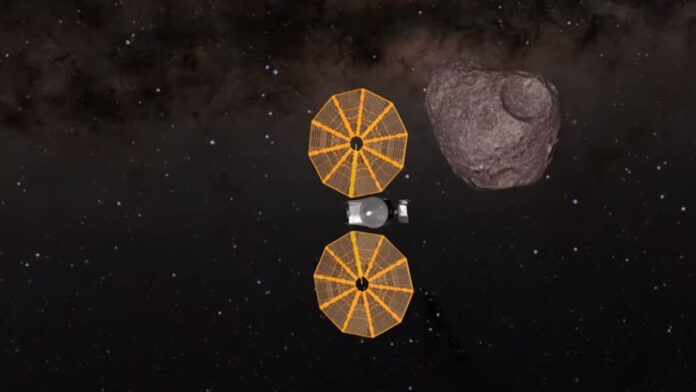Surprise Upon Surprise as NASA’s Speeding Spacecraft Finds Binary Asteroids Orbiting Larger Asteroid
NASA’s Lucy spacecraft recently zipped past the asteroid Dinkinesh at around 10,000 miles per hour on its journey to explore the Trojan asteroids near Jupiter. While observing Dinkinesh up close, the Lucy team made an unexpected discovery – the half-mile wide asteroid had a smaller asteroid, approximately 720 feet across, orbiting it.
But upon closer inspection, scientists realized the situation was even more complex. The smaller orbiting object was not one asteroid, but two asteroids touching each other, forming a “contact binary” asteroid pair.
This surprising find has fascinated scientists, as it is the first time a contact binary asteroid has been spotted orbiting another asteroid. The bizarre brightness variations Lucy observed as it approached Dinkinesh provided the first hints that Dinkinesh may have a moon. But no one expected the moon to be a dual asteroid system.
John Spencer, Lucy’s deputy project scientist at the Southwest Research Institute, remarked “We’ve been puzzling over odd variations in Dinkinesh’s brightness that we saw on approach, which gave us a hint that Dinkinesh might have a moon of some sort, but we never suspected anything so bizarre!”
Lucy’s Targets Offer Clues to Solar System Formation
The Lucy spacecraft is on a 12-year voyage to explore the swarms of Trojan asteroids that share Jupiter‘s orbit around the sun. These asteroids are thought to be relics from the early days of our solar system over 4 billion years ago. By studying them, scientists hope to gain key insights into planetary formation and the evolution of the solar system.
The mission planners wanted Lucy to fly by Dinkinesh first to test its ability to observe asteroids at high speed, before reaching the Trojans. This encounter produced more scientific bounty than expected.
Spencer commented “We haven’t seen many up close, and we’ve never seen one orbiting another asteroid. This is a completely unexpected scientific bonus for the mission.”
Understanding How Contact Binaries Form
In a contact binary, two asteroids of similar size are in contact with each other due to gravitational forces. Astronomers have observed many contact binary asteroids in the solar system’s asteroid belt between Mars and Jupiter. But Dinkinesh’s contact binary moon is the first known example of such an arrangement orbiting a larger asteroid.
Scientists are intrigued by how this exotic system developed. There are several theories on the formation of contact binaries, such as two separately formed asteroids getting pulled together, or fragmentation of a spinning asteroid into a dumbbell shape. Further analysis of Dinkinesh and its ‘moons’ may reveal new insights into these processes.
Upcoming Observations at Other Asteroids
The Lucy mission still has much to reveal about this trio of asteroids and the origins of our solar system. As the spacecraft travels on its circuitous path to the Trojan swarms, it will fly by another asteroid, Eurybates, in 2027. This will provide scientists an additional opportunity to observe an asteroid system up close.
Lucy, you’ve surprised us again
New images from the #LucyMission’s first asteroid flyby show that a satellite, already unexpected, is made of two objects – a contact binary. This is the first time we’ve seen a contact binary orbiting another asteroid. https://t.co/NwQfI6k7qz pic.twitter.com/WTSHNLyr86
— NASA Solar System (@NASASolarSystem) November 7, 2023
NASA is hailing Lucy’s first asteroid encounter as a major success. The spacecraft performed flawlessly, and delivered observations above and beyond the mission’s goals. As Lucy speeds deeper into the outer solar system, we can expect more exciting findings from this groundbreaking mission of discovery.


















![10 Countries With the Best Healthcare in the World [Statistical Analysis] Countries With the Best Healthcare in the World](https://articleify.com/wp-content/uploads/2025/07/Countries-With-the-Best-Healthcare-in-the-World-1-150x150.jpg)










